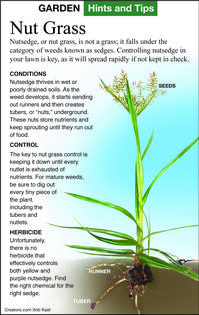The Greener View: Gardenias and Nut Grass
Q: I am trying to grow two gardenia plants in pots in the house. The buds and leaves are turning black. Can you help?
A: Gardenias have a wonderful fragrance and are worth having if you have the right conditions. They really need to stay warm, and at the same time, they need damp but not waterlogged soil. If you just bought them, did you place them near an air conditioner vent? Is it possible they dried out or got too cold during shipping? Put them in a warm window and don't let them dry out. Check the soil in the pot every day. Potted plants dry out much faster than gardenias growing in garden soil.
They need acidic soil like an azalea. If your water source has a high pH, it could cause the iron in the soil to become bound up so that the gardenia can't get it. You will see the leaves start to turn yellow, except that the leaf veins will stay green. Use bottled water and add a small amount of azalea fertilizer in each watering.
Q: Do you know of any surefire way of getting rid of nut grass? We have been fighting this stuff for three years. We tried the sprays that were supposed to eradicate it to no avail. We have also tried digging it out. Nothing seems to work. We think we have it under control, leave it for a couple of months, and it's as bad as it was in the beginning when we return. Any suggestions?
A: Nut grass is a sedge. It is also called water grass. If you cut the stem and look at the end, you will see that it is triangular, not round. It grows with underground roots and stems, and unlike grass, it also has tubers. All are capable of resprouting if the top is pulled off. It is a perennial, but it also easily spreads through seeds.
The best attack method is the shock and awe method of using everything at once and continue doing it until it is gone. Don't let any seeds grow by using a preemergent weed killer in the fall and spring to prevent the seeds from sprouting. Even if you have killed the existing plants, the seeds can sprout and replant the whole area again.
Pull the plants and runners out wherever you find it easy to do so, such as in flower beds with loose soil and mulch. The tubers begin developing along the roots after the plant has been growing for a month or two. They can be 18 inches below ground, so they will not be easily removed.
Use a spray that includes nut grass or nut sedge on the label and follow the directions for lawn and groundcover areas. Don't overdose by spraying too much at once or you may injure the lawn grass. Slow and steady progress is better than trying a quick kill. Many weeds come back weakened after herbicide treatments, but nut sedge has larger stores of food in the tubers, so it can recover quickly. You have to keep treating it until the mature plants are dead, and then you have to prevent the seeds from establishing a new population. Weakened lawns can allow more weed growth, so keep up with fertilizing and watering the lawn.
Speaking of watering, the reason it is also called water grass is because it grows very well in wet conditions that would harm lawn grasses. It will grow in drainage ways and in lawns that are overwatered by irrigation systems. Cut back on watering to slow the growth of the water grass.
========
Email questions to Jeff Rugg at info@greenerview.com. To find out more about Jeff Rugg and read features by other Creators Syndicate writers and cartoonists, visit the Creators Syndicate website at www.creators.com.
Copyright 2025 Jeff Rugg. Distributed By Creators.








Comments